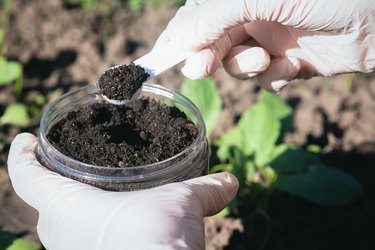
Soil with a high salt content robs plants of the nutrients they need, as their primary focus becomes trying to get enough water, leaving little energy for productive growth. Different plants respond differently to salinity, with some being highly tolerant and others incapable of thriving in too-salty soil. The primary way to address soil with a high saline content is by leaching, which means to wash a low-salt solution through the soil so that the saline content is flushed out.
Why Soil Becomes Salty
Video of the Day
The most common reason a home garden might have too much salt content in the soil is from irrigation, chemical fertilizers, or ice melters used on roads and sidewalks.
Video of the Day
Before addressing what you believe is too much salt in your soil, get a soil test to determine the level and type of salt. The recommended method is to take a sample from the top 6 inches and then another between 6 and 12 inches deep. There are multiple types of soil tests, some of which measure electrical conductivity, total dissolved solids, or soil pH. Ask your local university extension office for some guidance on the best type of soil test for your area and conditions.
How Plants React to High-Salt Soils
Plants growing in overly salty soils may grow slowly and become stunted. Their leaves may turn a dark green and can begin to thicken so that they resemble succulents. In extreme cases, the leaves will become burned and eventually necrotic. Given a high enough salt concentration, they will wilt and die.
One result of too-salty soil is that plants cannot get enough water. This is because magnetic interactions between the salt ions and water molecules restrict the movement of water in the soil, which means that water is less available to permeate plant roots. This is sometimes called "chemical drought."
Some plants are more susceptible to salt than others. For example, some salt-tolerant vegetables are beans, cabbage, celery, lettuce, carrots, peas, and sweet corn. Some veggies intolerant of salty soils include asparagus, beets, spinach, and squash, including pumpkins.
Managing Salty Soils
Poor drainage is a major factor in home garden soils with too-high salt content, so the first line of defense is to ensure proper drainage in your garden. If water pools anywhere in your yard when it rains, you have a drainage problem. If the problem is in a garden bed, adding compost and other organic matter can help drainage. Creating a slope away from the bed where the excess water can drain can also be helpful. If poor drainage is systemic throughout your yard, you may need to resort to special drainage ditches, French drains, or drain tiles.
Once good drainage is assured, the primary way to address salty soils is to water with clean, low-salt water. This can be highly effective. Applying only 6 inches of water can reduce the level of salinity by as much as 50 percent, while 12 inches of water reduces it 80 percent. The caveat is that the clean water must drain through the soil and not just pool and then run off the surface.
If your soil test warrants it, you can use gypsum, which is high in calcium and can help the salt leach from the soil. If your soil is on the sandy side, you can leach large amounts of salt in a season, but more clayish soils will take longer to leach salt. Apply garden gypsum to sandy loam soils at a rate of about 40 pounds per 1,000 square feet of soil. For more clayish soils, you can go as high as 80 pounds.